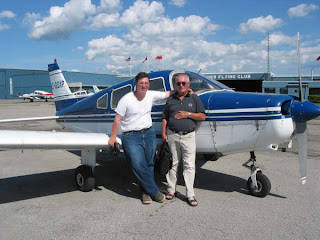Five months before Ernst Muller made his first flight in CF-FAM, my father was getting ready to leave the African plains for destinations unknown.
Work had either dried up in the equatorial sun or grown too stale and boring for his lofty tastes. In a pattern that would be re-exhibited several times over his life, my dad went on to something else.
His last flight in Africa was on April 19th, 1973 - a half hour, lunch time aerobatic jaunt in the RF-5.
He spent two weeks in Germany, in the Hesse town of Bottenhorn in the foothills of the Westerwald mountain range. He logged 46 minutes in ASK 13 gliders, did a dual flight in a Scheibe Falke motor glider and then ferried a Cessna 172 back from Breitscheid before continuing "home" to San Giacomo.
After three months, there were still no suitable job offers - at least nothing that piqued his interest.
 |
| My dad's glider logbook and an appropriately stern Hessian gaze in the accompanying photograph. (Family Collection) |
 |
| The 1st page of his glider logbook showing a dozen flights - 9 dual, 3 solo - for a total of 46 minutes. (Family Collection) |
After three months, there were still no suitable job offers - at least nothing that piqued his interest.
Then, one day in August, came a knock at the door.
Instead of the postman and a job offer, there were two carabinieri, Italian State Police, with orders to take Antonio F. Rotondo to the nearest military depot to be drafted into the Esercito Italiano.
And with that, my father became a 28-year-old private in the Italian Army.| Dad in his full dress uniform, 1974. (Family Collection) |
Until very recently, all Italian citizens were required by law to serve the nation - many of them through terms in the armed forces. My father had left Italy before being drafted and could return as long as he didn't stay longer than 3 months. He had overstayed his welcome by a week.
At 28, he was at least 5 years older than the oldest of his draftee class and not well suited to the typical barracks tomfoolery. The Italian Army hadn't won a battle since the height of the Roman Empire...and running around a field wantonly firing a sub-machine gun for enough money to buy a Coke and two slices of pizza wasn't his idea of a good time.He immediately made an appeal to his commanding officer to be transferred to the Air Force given he was an educated man with pilot training - not a hoodlum or a kid straight out of high school. His captain did the best he could - sending him to Naples in February to take a six-month course in becoming a wireless operator.
| Stamps and signatures from flying clubs in Bottenhorn Germany & Naples Italy. (Family Collection). |
 |
| P.66 I-POSI pictured in December 2008. This was the first P.66 my dad flew and the one he did most of his Naples flying in. (Photo Courtesy: Aero Club di Napoli) |
In June of 1974, he returned to his unit as a Marconista (wireless operator) and participated in manoeuvres where he rode around in a Armoured Personnel Carrier festooned with antennae in order to signal the other APCs and tanks in the battallion. He and his fellow wireless ops thought this was great fun until they realized, should their unit ever be sent into battle, their APC would be the first to be targeted.
With his mates outside their barracks near Bari, 1974 or 1975. My dad is 2nd from the left. (Family Collection)
|
Despite the forced nature of their employment and the futility of their actions, these were happy times. My dad recalled that they had little to worry about except to ensure that their boots were shined and pants pressed. Gags like exploding shaving cream canisters and swapping out tapes of Morse code signals for the chart topper of the day were common. They were well fed, well equipped and well respected. In those days, a soldier in uniform could hitchhike home and often did.
 |
| Two Italian Army wireless operators in full dress uniform. My dad is on the left. (Family Collection) |
My father was discharged from the army in the winter of 1975 after 18 months of service.








